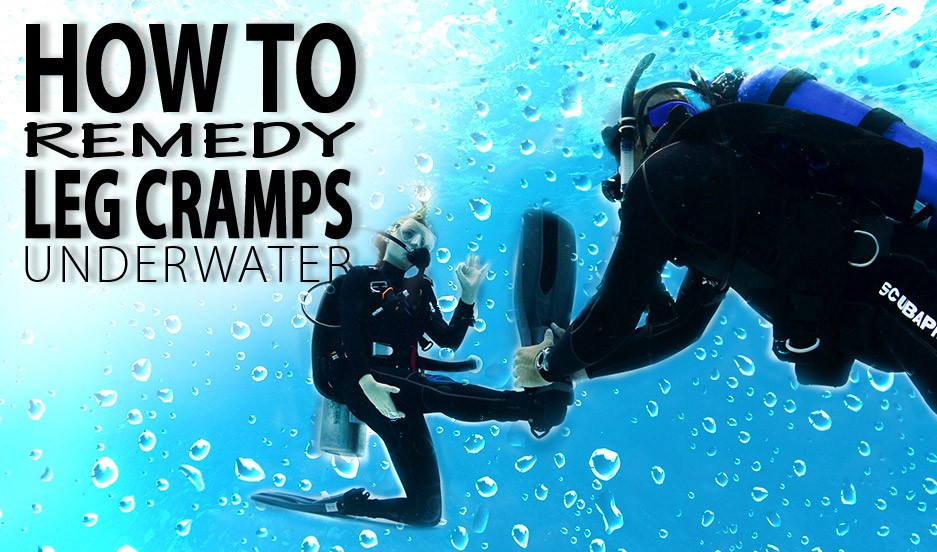You’re swimming along, just enjoying the dive. Suddenly, out of nowhere, it strikes. It feels like a ball of fire is consuming your leg as the searing pain hits. Shark attack? Nope. Eel bite? Still nope. This special agony can be a common issue for divers – the leg cramp.
Why Me?
So why do we occasionally suffer from leg cramps? And why are some people afflicted on a regular basis while others may never experience this joyful event? In simple terms, a muscle cramp is simply an involuntary contraction of a muscle that doesn’t relax. Muscles typically alternate between contracting and relaxing. When a muscle involuntarily contracts, it is said to be in spasm. If a spasm is hard enough and lasts long enough, it will become a cramp.
There are numerous issues that may trigger cramping, especially in the foot or calf. These include:
- Improper fin fit – too tight, squeezes your foot inhibiting muscle function and blood flow
- Improper boot fit – same reasons as above
- Fin straps too tight – pressure on the Achilles tendon causes calf muscle tension
- Wetsuit too restrictive – impairs range of motion
- Improper finning technique – more on this in a moment
- Improper fin selection – more on this later as well
- Muscle tightness – tight muscles are more prone to cramping
- Hydration – once thought to be the main cause of cramping; however, recent studies show this may not be the case, but that it may contribute
- Poor mineral nutrition – certain electrolytes like calcium, magnesium, and potassium play a role in muscle function and nerve signal transmission and are also thought to have a role in cramping
- Cold conditions – exertion in cold conditions tends to lead to cramping easily
Finning, Finning, Finning…
Specifically in diving, we often see cramping of leg muscles due to improper fin selection, improper finning technique, and/or working the calf muscle beyond its endurance. Avoiding cramps entirely may not be possible, but we can do quite a bit to help lower the chance.
Selecting a properly fitting fin with appropriate design features is a good starting point. Foot pockets need to have enough room to allow the foot to move and flex without being loose enough to cause problems with retention of the fin or cause chaffing. A foot pocket that doesn’t fit properly often leads to fins straps that don’t fit properly, putting pressure on the Achilles tendon. This leads to calf muscle tension that can develop into spasms and cramping.
Fin stiffness is also a consideration
Divers should select a fin that provides enough stiffness for their preferred kicking style without being too stiff. A diver that prefers the flutter kick will want a more flexible fin than a diver preferring the frog kick. Your local SDI dive center can assist you in selecting the appropriate fin for your diving.
How we employ our fins can have the largest impact. A diver employing poor finning technique (think bicycle kicks) is working their muscles hard for very little benefit, quickly working the muscle past its endurance and causing cramping. More efficient flutter kicking could help avoid this, as can even more efficient frog kicks. Sometimes just mixing up kicking styles on a dive can allow a group of muscles to relax a little while different muscle groups are employed in an alternate kicking style. A proficient diver will learn several finning techniques so they can employ the best option in different situations.
Taming the pain
So what can we do when we get a cramp? Most new divers are taught how to deal with this by simply stretching the affected muscle and possibly having a buddy assist. The idea here is to help the muscle relax instead of contract.
To stretch the muscle, you can begin by forming the figure four with the cramping leg by crossing your ankle over the opposite knee. Reach down and grab your fin tip. Then, extend the cramping leg while simultaneously pulling back on the fin tip. Exert a steady gentle force to stretch the affected muscle, you can even use the other hand to massage the cramp out. The cramp may be severe enough that your buddy may need to assist you in stretching the affected muscle. Just be aware of your buoyancy control so you don’t impact sensitive aquatic life or destroy the visibility.
If you know you’re prone to cramping, you can try to stay better hydrated. Stretching prior to diving may also help. Developing and maintaining a proper level of physical fitness for the diving you wish to do will go a long way to limiting cramps. And if all else fails, employ the old trick of drinking pickle juice – it’s thought that the salty, acidic taste tricks your body into relaxing the cramping muscle.
[hr style=”single”]
To find out more about International Training, visit www.tdisdi.com.
















 The diving world thrives on passion and adventure, but for many dive store owners, the financial and operational challenges can be as deep as the ocean.
The diving world thrives on passion and adventure, but for many dive store owners, the financial and operational challenges can be as deep as the ocean.

























